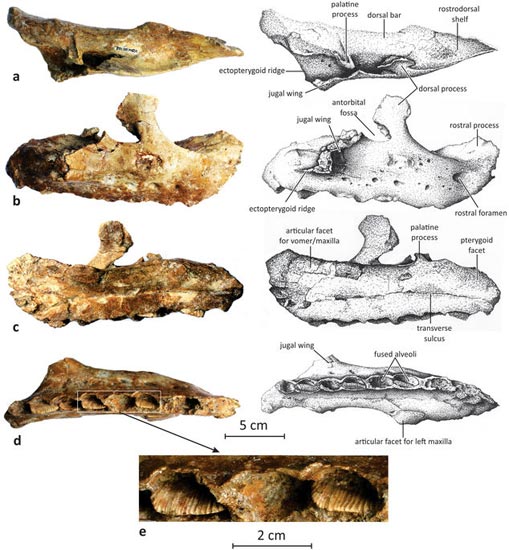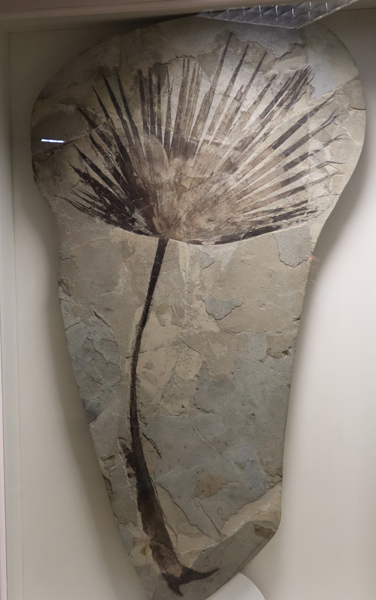What Big Teeth You Have! Matheronodon provincialis
New Ornithopod Dinosaur Described with Scissor-like Teeth
French and Belgian scientists have described a new species of plant-eating dinosaur which had scissor-like teeth, just the sort of dentition required to help it tackle tough, woody plants. The dinosaur has been named Matheronodon provincialis and assigned to the Rhabdodontidae family, ornithopods and part of the substantial and diverse Iguanodontia clade. Think of M. provincialis being distantly related to Iguanodon, Muttaburrasaurus and Mantellisaurus.
Matheronodon provincialis
An Illustration of the Skull and Jaws of Matheronodon provincialis
Picture credit: Royal Belgian Institute of Sciences (Lukas Panzarin)
Fossil Jawbone and Teeth
Field teams have been exploring the Upper Cretaceous sediments of Velaux-La Bastide Neuve, which lies to the north-west of the French city of Marseille for more than twenty-five years. This location has yielded numerous vertebrate fossils including dinosaurs, Pterosauria, crocodilians and turtles. The rocks in this region are estimated to be around 70 million years old (Campanian faunal stage of the Late Cretaceous). Field work carried out in 2009 and 2012 by the Royal Belgian Institute of Sciences found several scrappy and fragmentary ornithopod fossils including a right maxilla (upper jawbone) from a herbivore, estimated to have grown to around five metres in length.
The teeth in the jaw are oversized and few in number, especially when compared to the dental batteries associated with hadrosaurs. In addition, the jaw is robust and indicates that Matheronodon had a powerful bite.
Writing in the academic journal “Scientific Reports”, the authors, which include Pascal Godefroit (Directorate Earth and History of Life, Royal Belgian Institute of Natural Sciences), state that Matheronodon is characterised by the large teeth found in the upper and lower jaws, as well as the drastic reduction in the number of maxillary teeth (just four per generation).
The Holotype Fossil Material for Matheronodon provincialis (Right Maxilla)
Picture credit: Royal Belgian Institute of Sciences (Scientific Reports)
The picture above shows various views of the holotype fossil material, the right maxilla (MMS/VBN-02-102), (a) dorsal view, (b) lateral view, (c) medial view and (d) ventral view, with accompanying line drawings. Picture (e) is a close-up of the ventral view of the jaw showing the enlarged teeth. The researchers estimate that some of the individual teeth in the front portion of the maxilla were up to 6 cm long and 5 cm wide.
Honouring Philippe Matheron
The genus name honours the French 19th century palaeontologist Philippe Matheron, who named and described Rhabdodon (R. priscus), the dinosaur which lent its name to the Rhabdodontidae family. Lead author of the paper Pascal Godefroit commented:
“The denture of this group [rhabdodontids] had evolved in a different direction than that of their contemporaries, the hadrosaurs or duck-billed dinosaurs. Hadrosaurs had sophisticated dental “batteries” formed by little teeth with which they could crush conifers. Matheronodon and the other Rhabdodontidae probably ate leaves of palm trees, which were abundant in Europe at that time. They had to cut rather than crush the fibre-rich leaves, before they could swallow them.”
Cutting Palm Leaves – Playing the Role of the Ceratopsians
Matheronodon might have specialised in eating tough plant matter, plants such as Sabalites and Pandanites sp. which were abundant in the area during the Late Cretaceous. The teeth and jaws are described as “operating like self-sharpening serrated scissors”, the teeth have ridged surfaces but are covered with a thickened enamel layer on one side, as the jaw moves up and down, the side of the tooth with the thicker enamel resists wear more effectively than the dentine as it is exposed. As a result, the movement of the jaws as the animal chews, keeps the teeth sharp.
A Fossilised Palm Frond (Sabalites sp.) Green River Formation
Picture credit: Everything Dinosaur
Horned dinosaurs (ceratopsians) are relatively abundant in similarly aged deposits from North America, in contrast, rhabdodontids have not be found. The researchers suggest that in Europe dinosaurs like Matheronodon filled the niche occupied by the horned dinosaurs, as, although there have been accounts of Ceratopsian fossil discoveries in Europe, these fossils are very rare, indicating that horned dinosaurs only made up a tiny proportion of the total dinosaur biota. Ceratopsians and rhabdodontids probably competed for the same food resources, specialising in the consumption of tough, woody material such as palm leaves, an example of which from the Eocene Epoch (Sabalites sp.), is shown above.
The scientific paper: “Extreme Tooth Enlargement in a New Late Cretaceous rhabdodontid Dinosaur from Southern France” by Pascal Godefroit, Géraldine Garcia, Bernard Gomez, Koen Stein, Aude Cincotta, Ulysse Lefèvre and Xavier Valentin, published in the on-line, open access journal “Scientific Reports.”
Visit the Everything Dinosaur website: Visit Everything Dinosaur.




